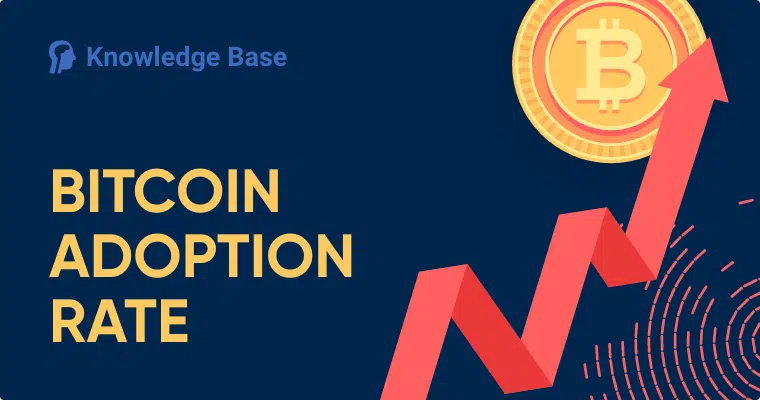Bitcoin Adoption Rate
The global Bitcoin adoption rate is surging, and 2021 was another big year for the digital currency.
Bitcoin and blockchain advancements are often compared to those of the internet, smartphones, and PayPal. And despite apprehension over its use on the Silk Road, the unstable price, scalability, and other criticisms, Bitcoin has an excellent track record dating back to 2009.
Bitcoin’s Origins
It’s strange to think about how a $5 investment in 2009 could have made you a present-day millionaire. The first known bitcoin to USD transaction was made by Finnish developer Martti Malmi, who sold 5,050 BTC for $5.02 in late 2009. This year, the Bitcoin price hit an all-time high of more than $64,000.
To understand the growth of Bitcoin, we have to go back to the very beginning. Satoshi Nakamoto published the white paper right after the global financial crisis of 2008 caused by mortgage-backed securities. Satoshi’s objective was to create a deflationary currency independent of financial institutions and run by a decentralized peer-to-peer network.
Transparency helped the cryptocurrency overcome the stigma of being used by unsavory individuals for illegal trade on the Silk Road.
Unsurprisingly, the online casino industry pioneered the use of cryptocurrency by accepting Bitcoin at online gambling venues. Playing online slots with Bitcoin was a thing not long after Laszlo Hanyecz dished out 10,000 BTC for two Papa John’s pizzas.
The Bitcoin adoption rate can also be seen with the constantly increasing trade volume and rising price. While Bitcoin’s price had its ups and downs, its upward trajectory is undeniable.
Number of Users
It’s hard to ascertain exactly how many active Bitcoin users there are. Bitcoin is often considered a store of value, and attempting to determine the exact number of Bitcoin users based on their activity could yield inaccurate results. There are anywhere between 500,000 and one million active Bitcoin addresses daily.
Bitcoin users make between 200,000 and 400,000 confirmed Bitcoin transactions per day. This is without counting Bitcoin’s transactions made on the Lightning Network, which can process more than one million transactions per second.
It’s hard to determine how many people own Bitcoin. However, there are some ballpark figures that we can use to determine the increasing adoption rate of BTC. There are more than 172 million addresses that make regular BTC transactions. This is out of 460 million addresses that have been created so far. Their number is constantly rising at a rate of hundreds of thousands per day. Keep in mind that new crypto investors most often generate wallets on exchanges, and there are more than 147 million of them.
However, determining the correct number of users is challenging, as many people have multiple account exchanges, use Bitcoin for betting at online casinos, or hold more than one Bitcoin wallet address.
BTC Price and Volume
Bitcoin’s adoption rate directly influenced its price and trading volume. News about another company accepting Bitcoin can change its price trajectory and set a new bullish trend on the market. Volume, while somewhat impacted by these changes, surged the most by the end of 2015 and in 2016. Daily volume reached the peak of $176 million per day in January 2016.
It’s hard to deny the high demand for Bitcoin despite the currency being declared dead more than 400 times since 2009, with many prophesying that it will drop to zero. An investment of $1,000 in 2010 would give you a nice profit margin of more than $410 million with the current price.
Businesses and Government Adoption
Bitcoin adoption as a payment method by major companies like Microsoft, PayPal, Starbucks, Tesla, Twitch, Rakuten, Home Depot, Etsy, and many others shows a positive trend. However, it’s important to note that there are different types of adoption. A company accepting crypto for its goods and services isn’t the same thing as a country adopting it as a legal currency. As such, many governments decided to accept Bitcoin and other cryptocurrencies as digital assets rather than putting them in the same category as fiat currencies.
But none of this undermines the surge in Bitcoin popularity as 2021 marked yet another record-breaking year. Other cryptocurrencies are also being more widely embraced. According to data by Chainalysis, the global adoption of cryptocurrencies increased by 880%. The research sought to identify countries with the most significant crypto adoption rate by ordinary citizens rather than institutions. It found that many emerging markets are turning to cryptocurrencies to protect their savings from inflation rates affecting their traditional currencies.
One such country is El Salvador, the first country to adopt Bitcoin as a legal tender to bolster its economy. Today, as the country expands its Bitcoin usage, more than 1.6 million Salvadorans are using Chivo Wallet, its official Bitcoin and USD wallet app.
Unfortunately, not every country is as open to cryptocurrencies as El Salvador. In the same year, Beijing intensified its clampdown on cryptocurrencies and the mining industry, triggering a migration of mining companies out of China.
Another blow for the industry came in the form of the recently approved $1 trillion infrastructure bill in the US. The bill requires cryptocurrency “brokers”, a broader term that could potentially encompass exchanges, miners, validators, decentralized app developers, and others, to report their users to the IRS so they can be taxed. Due to the nature of cryptocurrencies, this is something that wouldn’t be possible for anyone but exchanges.
Of course, crypto’s mass adoption hasn’t been realized in the US, but the industry now has a lobby that’s putting pressure on lawmakers and other politicians.
FAQ
Which country will adopt Bitcoin?
El Salvador is currently the only state that uses Bitcoin as a legal tender, which makes it an equal to the country’s traditional national currency.
Is Bitcoin in early adoption?
Bitcoin has been in the market since 2009, and according to experts, it has surpassed its “early adopters” stage, and it’s currently in the “early majority” phase. This is good news for investors. The current Bitcoin adoption rate hasn’t reached the “late majority” stage when there will be diminishing returns on investment.
Which country owns most Bitcoin?
Currently, the US is the country that trades the most with Bitcoin. According to statistics, more than $1.5 billion worth of BTC circulated on US-based cryptocurrency exchanges in 2020.






